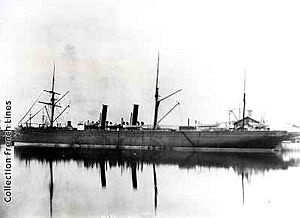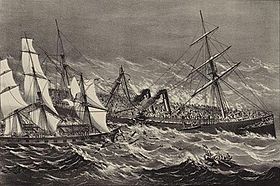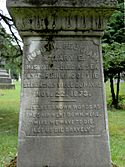SS Ville du Havre facts for kids

Ville du Havre
|
|
Quick facts for kids History |
|
|---|---|
| Name | Ville du Havre |
| Namesake | Le Havre |
| Builder | Thames Iron Works Co |
| Launched | 2 November 1865 |
| In service | 26 April 1866 |
| Out of service | 22 November 1873 |
| Fate | Sunk after collision with Loch Earn |
| Notes | Originally named Napoléon III |
| General characteristics | |
| Type | Ocean liner |
| Tonnage | 5,065 tons |
| Length | 128.50 metres |
| Beam | 14.08 metres |
| Depth of hold | 22 ft 4 in (6.81 m) |
| Propulsion | 1 compound inverted 4 cylinders |
The Ville du Havre (pronounced "veel doo ahv-ruh") was a large French steamship. It was made of iron and traveled back and forth between France and New York City. The ship was first launched in November 1865. Its original name was Napoléon III.
In 1871, the ship was changed from a paddle steamer to use a single propeller. At this time, its name was changed to Ville du Havre. This new name honored Le Havre, a major port city in northern France. The change also recognized that Emperor Napoleon III had recently lost power.
Sadly, in the early morning of November 22, 1873, Ville du Havre crashed into another ship. This ship was a British iron clipper called Loch Earn. The Ville du Havre sank in just 12 minutes. A total of 226 people lost their lives. Only 61 passengers and 26 crew members survived. They were rescued first by Loch Earn and then by an American ship named Tremountain.
Contents
The Ship's Journey: From Paddle Wheels to Propeller
The Napoléon III was built in London by Thames Ironworks in late 1865. It was designed for the Compagnie Générale Transatlantique, also known as the French Line. The ship was 3,950 tons and about 111.5 meters (365.9 feet) long. It had a width of about 14 meters (45.9 feet).
The ship had two funnels and two masts. It was built of iron and moved using large paddle wheels. It could travel at a speed of about 11.5 knots. The ship could carry many people. There was space for 170 first class passengers. It also had room for 100 second class and 50 third class travelers.
The Napoléon III began its first trip on April 26, 1866. It sailed from Le Havre to Brest and then to New York City. It completed five round trips on this route. Its last trip started in August 1869.
In September 1871, the ship sailed to Tyneside in Northern England. Here, it was made longer by A. Leslie and Company. The ship grew to about 128.5 meters (421.7 feet) long. Its weight increased to 5,065 tons. Workers also installed new compound steam engines. They removed the old paddle wheels and gave the ship a single propeller. A third mast was also added. After these changes, the ship was renamed Ville du Havre. It started its trips between Le Havre, Brest, and New York again in early 1873.
The Final Voyage and Sinking
On November 15, 1873, the Ville du Havre left New York. It had 313 passengers and crew on board. Captain Marino Surmonte was in command. The ship was heading for Havre de Grâce, France.
About halfway across the Atlantic Ocean, a terrible accident happened. Around 2:00 AM on Saturday, November 22, the ship crashed. It collided with the iron clipper Loch Earn. The crash happened at coordinates 47°21′N 35°31′W. At the time, Ville du Havre was moving at about 12 knots. It was using both its steam engine and sails.
The captain of Loch Earn saw Ville du Havre coming too close. He rang his ship's bell and turned his ship to the right. But Ville du Havre came right across the front of Loch Earn. The collision shook Ville du Havre violently. All the passengers woke up. Many rushed to the deck, confused. They soon saw that the ship was sinking fast.
The captain tried to calm everyone, but the ship was badly damaged. It was almost broken in half. Passengers quickly realized how serious the situation was. Panic and confusion spread. People grabbed life preservers. They tried to launch the lifeboats. But the lifeboats had recently been painted. They were stuck to the deck. A few were finally pulled free. Passengers fought to get into them.
Soon after the crash, Ville du Havre's main and mizzen masts fell. They crushed two of the ship's lifeboats. Several people were killed. There was very little time to save lives. The ship sank in less than 12 minutes. It broke into two pieces as it went down.
Captain Robertson of Loch Earn did everything he could to rescue people. He saved 26 passengers and 61 crew members. They were taken aboard his ship. However, 226 passengers and crew members died.
The Loch Earn was also in danger of sinking. It was later rescued by an American cargo ship called Tremountain. All the survivors from Ville du Havre were moved to the Tremountain. The Loch Earn's front was badly damaged. It began to sink as its inner walls broke. So, its crew left the ship. It sank shortly after. The Loch Earn had been traveling from Bristol to New York.
Notable Passengers on Board
Several well-known people were on the Ville du Havre's final voyage.
Rufus Wheeler Peckham was a judge and a politician from New York. He was traveling with his wife, Mary. Both of them died in the sinking. They were going to southern France because Mr. Peckham was not well. His last words were said to be, "Wife, we have to die, let us die bravely." His body was never found. A special memorial, called a cenotaph, was put up for him. It is in the Albany Rural Cemetery in Menands, New York.
Hamilton Murray, a graduate of Princeton University, also died. His sister Martha died with him. The Hamilton Murray theater at Princeton was later named in his honor. He had left $20,000 to the university in his will. Other victims included Victor Collodion, a French artist who drew funny pictures, and his wife. Felipe Larrazábal, a musician, lawyer, and politician from Venezuela, also perished.
The Spafford Family Tragedy
Horatio Spafford was a lawyer from Chicago. He was also a leader in his church. He was supposed to be on the Ville du Havre. But at the last minute, he had to stay for some business. So, his wife, Anna Spafford, who was from Norway, went ahead. She traveled to Paris with their four daughters.
After the collision, only Mrs. Spafford was rescued. She was found unconscious, floating on a piece of wood. She was then taken aboard the Loch Earn. Another survivor, Pastor Nathanael Weiss, later said that Anna Spafford told him, "God gave me four daughters. Now they have been taken from me. Someday I will understand why".
Nine days after the shipwreck, the survivors arrived in Cardiff, Wales. Anna Spafford sent a telegraph message to her husband. It simply said, "Saved alone. What shall I do . . ." When Horatio Spafford received her message, he immediately left Chicago. He wanted to bring his wife home.
During his trip across the Atlantic, the ship's captain called Spafford to his cabin. The captain told him they were passing over the exact spot where his four daughters had drowned. The water there was three miles deep. Spafford later wrote to his wife's half-sister, Rachel. He said, "On Thursday last we passed over the spot where she went down, in mid-ocean, the waters three miles deep. But I do not think of our dear ones there. They are safe, folded, the dear lambs". During that same trip, Spafford wrote the famous church song It Is Well with My Soul. Philip Bliss, who wrote the music for the song, named his tune Ville du Havre, after the ship that sank.
Gallery





